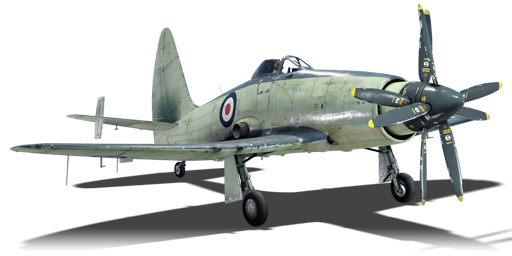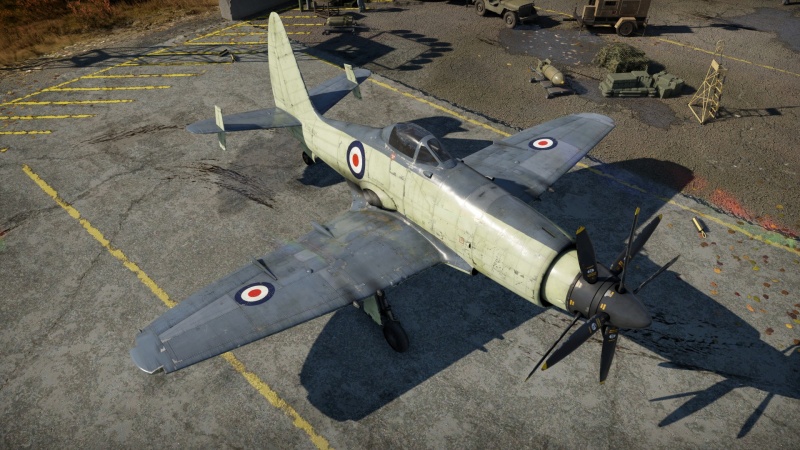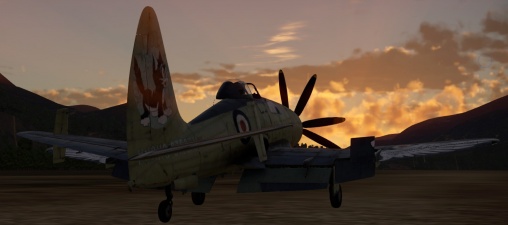Difference between revisions of "Wyvern S4"
The0Doctor (talk | contribs) m ("kph" has been updated to "km/h, " a correct abbreviation of speed in the metric system.) (Tag: Visual edit) |
Isaac_Victor (talk | contribs) (→Pros and cons) (Tag: Visual edit) |
||
| Line 160: | Line 160: | ||
* Surprisingly high climb rate | * Surprisingly high climb rate | ||
* Reasonably capable of Boom & Zoom, which will allow this premium plane to make even more money | * Reasonably capable of Boom & Zoom, which will allow this premium plane to make even more money | ||
| + | * In addition to carrying 3x1000lbs, you can release one separately from the other | ||
| + | * It has airbreak, a rare item in his BR | ||
'''Cons:''' | '''Cons:''' | ||
Revision as of 18:18, 28 June 2023
Contents
Description
The Wyvern S4 is a premium gift rank IV British strike aircraft with a battle rating of 4.3 (AB/RB) and 5.3 (SB). It was introduced in Update 1.59 "Flaming Arrows".
The Wyvern S4 can carry great amounts of payload due to its distinctive feature, the turboprop powerplant. This engine enables it to exceed 600 km/h in level flight.
The Wyvern is an aircraft that can carry a large payload so it can be used in the strike fighter role. One of its most popular payloads, 16 x RP-3 , enables it to destroy a large amounts of targets with medium armour like light pillboxes and up to heavy tanks. The Wyvern is also a strong fighter, below 3,000 m. As the Wyvern does not have a compressor of any sorts, engine power drops significantly above 3,000 m. Keeping altitude at 3,000 and doing Boom & Zoom or Boom & Run attacks are of the most successful fighting doctrines. Although the Boom & Zoom attack will most likely bleed the Wyvern's speed very quickly, employing Boom & Run instead of this attack is recommended when possible.
General info
Flight performance
The Wyvern S4, being a turboprop, is an exceptionally fast aircraft for its battle rating. Though a prop aircraft, the Wyvern functions very similar to jet aircraft in play style, due to the nature of its weight and engine. Though the Wyvern does have an above average climb rate due to its powerful engine, it functions best near sea level. At sea level, where the engine functions at maximum capacity, the Wyvern is almost uncatchable. Being able to maintain nearly 640 km/h in level flight without a payload, even enemies diving on the Wyvern will have trouble catching up, and will quickly fall behind as they lose energy.
Though it can go incredibly fast, this is solely due to the aircraft's powerful turboprop engine. Coming in at a heavy 7 tonnes with no payload, or 9 and a half tonnes with its maximum payload, the Wyvern's speed suffers when performing any manoeuvre bar going in a straight line. Even minor adjustments will cause the fighter to bleed speed at an alarming rate, with full-out turns able to halve the aircraft's speed before it has even completed a 180. Whilst it has the speed, the Wyvern can turn very fast but as mentioned it will lose this speed in the turn very quickly. Unless absolutely necessary, avoid performing any but the most gentle of manoeuvres in this 7 tonne beast.
This focus on simply flying straight is further amplified by the turboprop's ability, or lack thereof, to quickly react to input changes. As happens in jet aircraft, the turboprop engine found on the Wyvern will take a fairly long amount of time to react to changes to the throttle meaning the Wyvern pilot will struggle to regain speed if the throttle is dropped at any point, such as to recover from a vertical stall manoeuvre.
| Characteristics | Max Speed (km/h at 0 m - sea level) |
Max altitude (metres) |
Turn time (seconds) |
Rate of climb (metres/second) |
Take-off run (metres) | |||
|---|---|---|---|---|---|---|---|---|
| AB | RB | AB | RB | AB | RB | |||
| Stock | 635 | 620 | 9000 | 33.3 | 33.6 | 21.1 | 21.1 | 700 |
| Upgraded | 665 | 650 | 31.2 | 32.0 | 24.7 | 23.0 | ||
Details
| Features | ||||
|---|---|---|---|---|
| Combat flaps | Take-off flaps | Landing flaps | Air brakes | Arrestor gear |
| ✓ | ✓ | ✓ | ✓ | ✓ |
| Limits | ||||||
|---|---|---|---|---|---|---|
| Wings (km/h) | Gear (km/h) | Flaps (km/h) | Max Static G | |||
| Combat | Take-off | Landing | + | - | ||
| 844 | 330 | 566 | 351 | 315 | ~10 | ~7 |
| Optimal velocities (km/h) | |||
|---|---|---|---|
| Ailerons | Rudder | Elevators | Radiator |
| < 482 | < 400 | < 410 | N/A |
Survivability and armour
- 64 mm Bulletproof glass - Armoured windscreen
- 12.7 mm Steel plate behind the pilot
Modifications and economy
Armaments
Offensive armament
The Wyvern S4 is armed with:
- 4 x 20 mm Hispano Mk.V cannons, wing-mounted (300 rpg = 1,200 total)
Suspended armament
The Wyvern S4 can be outfitted with the following ordnance:
- Without load
- 3 x 500 lb G.P. Mk.IV bombs (1,500 lb total)
- 3 x 1,000 lb M.C. 1,000 lb Mk.I bombs (3,000 lb total)
- 8 x AP Mk I rockets
- 8 x RP-3 rockets
- 16 x AP Mk I rockets
- 16 x RP-3 rockets
- 1 x 450 mm 18 inch Mark XV torpedo
- 16 x RP-3 rockets + 1 x 450 mm 18 inch Mark XV torpedo
- 2 x Red Angel rockets
Usage in battles
Speed, climb rate, and armament are the Wyvern's only real method of taking out enemy aircraft. These are the strengths that any pilot of the Wyvern should always exploit, by employing Boom & Run tactics on enemies. With four Mk V Hispano cannons, and a staggeringly large ammo reserve, the Wyvern is more than equipped to quickly dispatch any aircraft that end up in front of it. The pilot should only take the plane up to a maximum of a couple thousand meters, unless bomber hunting, and use the Wyvern's excellent acceleration and top speed to quickly annihilate any enemies who end up on low altitude. The Wyvern can also use this speed to bait enemies, who see the Wyvern as an easy target, down to low altitudes. This will allow allied fighters to easily establish high altitude air superiority, which can often end up in victory by itself, without the Wyvern pilot actually putting himself in any great danger.
With its wide variety of secondary armaments, the Wyvern is one of the best aircraft available to the British at this BR. Typically, load up three 1,000 lb bombs, and use them to fully destroy one bombing point. The Wyvern is taken to its maximum weight whilst carrying this payload, and will only be able to maintain around 550 km/h at sea level, so the pilot should attempt to drop the bombs as soon as he can, to regain the Wyvern's 640 km/h top speed. Using the four Mk V Hispano cannons, preferably with Air Targets ammunition loaded, employ the Wyvern as was detailed in the above section, as a boom-and-zoom aircraft at low altitude. If one had experience flying any jet aircraft in the past, use the Wyvern exactly as a jet. Do not turn for anyone, if a pass misses then continue onward until a great distance is gained, then turn around for another guns run.
While fighting, any pilot should refrain from turn fighting and perform energy fighting whenever possible
In Ground Forces, the pilot has the choice between using three 500 lb bombs, three 1,000 lb bombs, sixteen RP-3 rockets, or sixteen AP Mk I rockets. With such an armament, the Wyvern's distinctive engine sound can signal in the incoming doom of any tank unfortunate enough to end up in the pilot's vision.
In Naval Battles, the Wyvern can be used as a fighter-bomber. The 3 x 1,000 lb bombs will allow you to destroy most targets with direct hits and once free of the bomb load you are free to kill any other bombers or fighters around with relative ease.
Manual Engine Control
| MEC elements | ||||||
|---|---|---|---|---|---|---|
| Mixer | Pitch | Radiator | Supercharger | Turbocharger | ||
| Oil | Water | Type | ||||
| Not controllable | Controllable Auto control available |
Not controllable Not auto controlled |
Not controllable Not auto controlled |
Combined | Not controllable 1 gear |
Not controllable |
Pros and cons
Pros:
- Exceptional low-altitude engine performance (550 km/h-640km/h with payload/no payload)
- Powerful offensive armament, with large ammo reserves
- Diverse selection of secondary armament
- Above average manoeuvrability at high speeds
- Excellent dive performance
- Surprisingly high climb rate
- Reasonably capable of Boom & Zoom, which will allow this premium plane to make even more money
- In addition to carrying 3x1000lbs, you can release one separately from the other
- It has airbreak, a rare item in his BR
Cons:
- Exceedingly heavy (7 t unloaded, 9+ t with a payload)
- Large fuel tanks located in front of the wings
- Turboprop engine is more fragile than traditional piston-engines planes
- Very bad roll rate
- Below average high-altitude engine performance
- Poor engine response to throttle adjustment
- Distinctive engine sound, unlike any other aircraft
- Extremely loud propulsion system allows for easy detection
History
The Wyvern was one of the few turboprop combat aircraft ever fully developed, and entered service long after World War II had ended. The design was a relic of an era past, with jet-powered aircraft now replacing propeller aircraft. It also suffered from a long development period, beginning in 1944 as the P.10. This lead to the Wyvern seeing very little combat use and being quickly retired. The Wyvern S.4 variant contained an Armstrong Siddeley Python 3 turboprop engine, able to output 3670 horsepower, and was the first and only variant of the Wyvern to enter service with the British Royal Navy.
The Wyvern S.4 only saw actual combat in late 1956 during the Suez Crisis, racking up 79 sorties and 2 losses. This marked the Wyvern as the only British turboprop to ever see combat.[1]
The type was plagued with various engine problems during its brief period in service, and was retired soon after in 1958.
Media
- Skins
- Images
- Videos
See also
Links to the articles on the War Thunder Wiki that you think will be useful for the reader, for example:
- reference to the series of the aircraft;
- links to approximate analogues of other nations and research trees.
External links
- [Devblog] Westland Wyvern: The Turboprop Dragon
- Official data sheet - more details about the performance
References
| Westland Aircraft Limited | |
|---|---|
| Aircraft | |
| Fighters | Whirlwind Mk I · Whirlwind P.9 |
| Turboprop | Wyvern S4 |
| Helicopters* | |
| Attack | AH Mk.1 Apache** |
| Utility | Wessex HU Mk.5 · Scout AH.Mk.1 · Wasp HAS.Mk.1 · Lynx AH.Mk.1 · G-LYNX |
| *After World War II, Westland Aircraft focused on building helicopters and changed its name to Westland Helicopters. | |
| **Licensed AH-64D | |
| See Also | Boeing Aircraft |
| Britain strike aircraft | |
|---|---|
| Blackburn | Firebrand TF Mk IV · Firecrest |
| Bristol | Beaufighter Mk I (40-mm) · Beaufighter Mk VIc · Beaufighter Mk X · Beaufighter Mk 21 |
| CAC | ▄Wirraway |
| Fairey | Firefly F Mk I · Firefly FR Mk V |
| de Havilland | Mosquito FB Mk VI · Mosquito FB Mk XVIII |
| Hawker | Hurricane Mk IV · Tempest Mk V (Vickers P) |
| Westland | Wyvern S4 |
| Britain premium aircraft | |
|---|---|
| Fighters | Tuck's Gladiator Mk II · ▄Boomerang Mk I · ▄Boomerang Mk II · ▄D.520 |
| ▄Martlet Mk IV · ▄Corsair F Mk II · ▄Hellcat Mk II · ▄Thunderbolt Mk.1 · ▄Mustang Mk IA | |
| Hurricane Mk.I/L FAA M · Spitfire Mk.IIa Venture I · Spitfire F Mk IXc · Plagis' Spitfire LF Mk IXc · Spitfire F Mk XIVc · Prendergast's Spitfire FR Mk XIVe | |
| Typhoon Mk Ib · MB.5 | |
| Twin-engine fighters | Hornet Mk.I · Whirlwind P.9 |
| Jet fighters | Attacker FB.2 · Hunter FGA.9 · Lightning F.53 · Meteor F Mk.8 Reaper · Sea Vixen F.A.W. Mk.2 · F-4J(UK) Phantom II · ▄MiG-21 Bison |
| Strike aircraft | ▄Wirraway · Beaufighter Mk I (40-mm) · Wyvern S4 |
| Harrier GR.1 · Strikemaster Mk.88 | |
| Bombers | ▄Avenger Mk II · ▄Boston Mk I · ▄Catalina Mk IIIa · ▄DB-7 · ▄Havoc Mk I · ▄Hudson Mk V · Swordfish Mk II |






